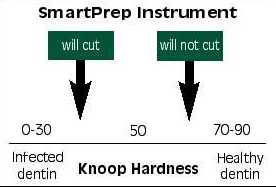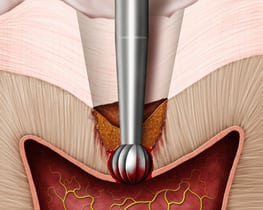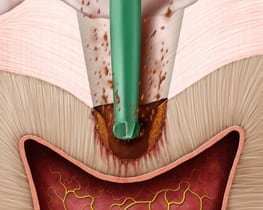SmartPrep Instruments
(Smart Bur, Polymer Bur)
Concept
It’s a medical polymer that has the ability to remove decayed dentine while keeping the healthy dentin.
It’s based on the concept that its hardness is less than healthy dentine while harder than the carious dentin.
Thus, it has the ability to self-limit(selectively) what it cuts, which means it will only cut what is carious and if it’s in contact with healthy dentin the bur will only wear away (when extensive force isn’t used) .
Technique
- It is used on low speed handpiece (500 – 800 up too 4000 rpm).
- The Movement is circular starting from the center to out.
- Must not use great force or healthy dentin will be damaged.
- Best used when Caries is very deep with Very thing remaining dentine bridge( it’s the amount of dentine between the pulp and crown) thus to prevent the possibility of exposure.
- The bur has different sizes (4, 6, and 8).


Advantages
- Very conservative
- Minimal to none disease transfer (because its single use only).
- No need for Local Anesthesia.
- Great for Students to start with during first clinical cases.
Disadvantages
- Single-patient-use = Expensive.
- Technique sensitive ( too much pressure and you will cut the healthy dentine)
- The bur breaks down when it touches enamel.
- It can sometimes leave large amounts of decayed tissue (use caries dye to locate the left amount.
- Access should be done by a different type of bur that can penetrate the enamel.
Research
A research by Howard E. Strassler Stated in Inside Dentistry July/August 2011, Vol.7 , issue 7, that:
“A unique, medical-grade polymer bur, SmartBur II is a self-limiting caries removal bur for use in a slow-speed handpiece operating at up to 4,000 rpm. Research demonstrates that when compared to a carbide metal bur and ceramic bur, the polymer bur is truly dentin safe and will not cut sound, healthy dentin. Using the SmartBur II allows for preservation of sound, healthy tooth structure and can protect against unnecessary pulp exposures. In this author’s experience, some patients have not had the need for local anesthesia for caries removal in Class I and Class V preparations.”
Howard E. Strassler, DMD
Professor, Division of Operative Dentistry
Department of Endodontics, Prosthodontics, and Operative Dentistry
University of Maryland Dental School
Baltimore, Maryland
Demonstration
OziDent Members Only
The rest of article is viewable only to site members,Please Register and/ or Confirm registration via EmailHere.If you are an existing user, please login.